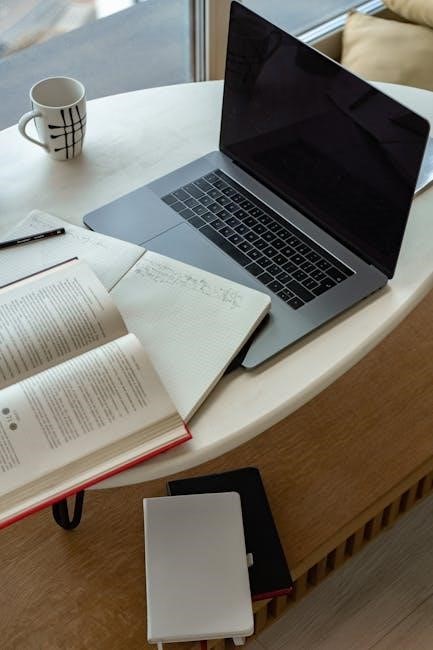Understanding women’s pants sizes is key to a perfect fit. Measurements, body types, and styles vary, making it essential to know your size for comfort and confidence.
1.1 Understanding the Importance of Proper Fit
A proper fit is essential for comfort, confidence, and style. Ill-fitting pants can cause discomfort and an unflattering appearance, while the right fit enhances posture and movement. Poorly fitted pants may sag, stretch, or restrict, affecting both aesthetics and functionality. Achieving the right fit ensures pants drape naturally and accommodate your body type. Consulting size guides and measuring accurately helps avoid common issues like gaping waistbands or tight hems. Prioritizing proper fit elevates your wardrobe, ensuring a polished and comfortable look. Always consider your body type and lifestyle when selecting pants for the best results.
1.2 Overview of Size Systems for Women’s Pants
Women’s pants sizes vary across regions and brands, with systems differing internationally. French, US, and EU sizes are common, each using unique measurements. While French sizes often align with waist and hip measurements, US and EU systems may vary slightly. Some brands use letter labels (XS-XL) alongside numerical sizes, adding flexibility. Understanding these systems is crucial for accurate fit. International size charts help bridge differences, ensuring consistency. Always refer to specific brand guides for precise measurements, as sizing can differ between labels and regions. This ensures a tailored fit for every body type and style preference.

How to Measure for Women’s Pants
Measuring waist, hips, and inseam is essential for determining women’s pants sizes. Keep the tape measure level and not too tight for accurate results.
2.1 Taking Waist Measurements
For accurate waist measurements, stand upright and place the tape measure around the narrowest part of your torso, typically just above the belly button. Ensure the tape is level and not too tight, as this can compress the measurement. Breathe naturally to avoid any distortion. This measurement is crucial for determining the ideal pants size, especially for styles that sit at the natural waistline. Proper alignment ensures a comfortable and flattering fit.
2.2 Measuring Hip and Inseam
Measure your hips by wrapping the tape around the widest part, approximately 20-23 cm below your natural waistline. Ensure the tape is level and not twisted. For inseam, measure the inside of your leg from the crotch seam to the ankle bone. This determines the pant length. Accurate hip and inseam measurements are vital for ensuring the pants fit well and maintain their intended style. Proper alignment and a relaxed stance during measurement are key to achieving the best results.
2.3 Understanding Body Types and Their Impact on Fit
Body types significantly influence pant fit. Pear-shaped women have wider hips, requiring pants with a balanced waist and hip ratio. Hourglass figures benefit from high-waisted styles that accentuate curves. Rectangular body types can opt for slim or straight-leg pants to add shape. Petite women should avoid overly long inseams, while tall women can embrace longer styles. Understanding your body type ensures a flattering fit, as measurements alone may not account for proportions. Tailoring pants to your silhouette enhances comfort and confidence.

Guide to Women’s Pants Size Charts
Women’s pants size charts provide standardized measurements for waist, hips, and inseam, ensuring a precise fit. International comparisons help women find their size across different systems.
3.1 Standard French Size Conversions
In France, women’s pants sizes are determined by body measurements, particularly waist and hip circumference. Sizes typically range from 34 to 46, corresponding to specific centimeter measurements. For example, size 34 equates to a 58-62 cm waist and 84-88 cm hips, while size 46 corresponds to a 94-98 cm waist and 118-122 cm hips. These measurements ensure a tailored fit, with each size reflecting a standardized increment. Understanding French size conversions helps women shop confidently, both domestically and internationally, by aligning their measurements with the appropriate size category.
- Size 34: Waist 58-62 cm, Hips 84-88 cm
- Size 36: Waist 62-66 cm, Hips 88-92 cm
- Size 38: Waist 66-70 cm, Hips 92-96 cm
- Size 40: Waist 70-74 cm, Hips 96-100 cm
- Size 42: Waist 74-78 cm, Hips 100-104 cm
- Size 44: Waist 78-82 cm, Hips 104-108 cm
- Size 46: Waist 82-86 cm, Hips 108-112 cm
3.2 International Size Comparisons (US, UK, EU)
Understanding international size differences is crucial for women shopping across borders. French sizes (EU) typically align with measurements, while US and UK sizes vary by brand. For example, a French size 36 corresponds to a US size 4-6 and a UK size 8-10. These comparisons help bridge the gap in sizing standards, ensuring a consistent fit regardless of the region. By referencing these comparisons, women can confidently purchase pants that match their body measurements, eliminating guesswork and size discrepancies between countries.
- French 34: US 2-4, UK 6-8
- French 36: US 4-6, UK 8-10
- French 38: US 6-8, UK 10-12
- French 40: US 8-10, UK 12-14
- French 42: US 10-12, UK 14-16
3.3 Plus-Size and Curvy Fit Options
Plus-size and curvy women can find flattering pants by focusing on styles that enhance their silhouette. High-waisted designs often provide better support and comfort. Curvy fits typically feature a more generous hip and thigh measurement, ensuring a smooth, tailored look. Many brands offer extended size ranges, catering to diverse body types. These options emphasize confidence and style, ensuring that every woman can enjoy well-fitting pants regardless of her size. Detailed sizing charts help guide the selection, making shopping more accessible and enjoyable for all.
- High-waisted styles for added support
- Curvy fits with tailored proportions
- Extended size ranges for inclusivity
- Detailed sizing charts for accuracy

Factors Affecting Pant Fit
Fabric type, stretch, and rise height significantly impact pant fit. Different materials offer varying comfort, while stretch enhances flexibility. High, mid, or low rises cater to diverse preferences, ensuring optimal comfort and style for every body type.
4.1 Fabric and Stretch
Fabric and stretch play a crucial role in pant fit. Stretchy materials like elastane provide flexibility, while rigid fabrics offer structure. The right fabric ensures comfort and durability, adapting to body movements. Understanding fabric types helps choose pants that maintain shape and provide support. Stretch fabrics are ideal for active lifestyles, while non-stretch fabrics offer timeless appeal. Balancing fabric choice with personal comfort ensures a flattering and functional fit for every occasion.
4.2 Rise Types (High, Mid, Low)
Rise types significantly impact pant fit and comfort. High-rise pants offer coverage and support, often emphasizing waistlines. Mid-rise strikes a balance, fitting most body types. Low-rise styles provide a trendy, modern look, ideal for fashion-forward individuals. Each rise type caters to different body shapes and preferences, ensuring a personalized fit. Choosing the right rise enhances both aesthetics and comfort, making it a key consideration when selecting women’s pants.
4.3 Pant Styles (Slim, Straight, Wide Leg)
Pant styles vary to flatter different figures. Slim-fit pants hug the legs, ideal for petite frames. Straight-leg pants offer a classic look, balancing proportions. Wide-leg styles create a flowing silhouette, suiting taller women. Each style enhances body shape, ensuring a tailored appearance. Understanding these options helps in selecting pants that align with personal aesthetics and body types, making every woman feel confident and stylish in her choice of pant style.

Choosing the Right Pant Style for Your Body
Discover the perfect pant style to enhance your silhouette. Slim-fit suits petites, wide-leg balances curves, and straight-leg offers timeless appeal. Find your ideal match for confidence and style.
5.1 Best Styles for Pear-Shaped Figures
Pear-shaped figures benefit from pant styles that balance the hips and thighs. High-waisted designs and wide-leg cuts create a proportional silhouette, drawing attention upward. Flared or bootcut styles skim over the hips, while slim pants with stretch offer comfort. A belted waist enhances definition, creating a more balanced look. Avoid clingy fabrics that accentuate curves. Opt for structured fabrics or details like pockets to distract from the hips; These styles ensure a flattering, confident fit for pear-shaped women.
5.2 Flattering Options for Petite Women
Petite women can enhance their silhouette with tailored pants that create length and balance. High-waisted styles elongate the legs, while slim or straight-leg designs avoid overwhelming the frame. Look for pants with a shorter inseam to ensure a perfect fit. Vertical stripes or subtle patterns can create a slimming effect. Avoid overly voluminous fabrics or wide-leg cuts, as they can visually shorten the legs. Streamlined designs with stretch fabric offer both comfort and a flattering, polished look for petite women.
5.3 Stylish Choices for Tall Women
Tall women can embrace their height with pants that elongate and balance proportions. High-waisted styles and wide-leg or flared designs create a balanced silhouette. Look for pants with a longer inseam to ensure a tailored fit. Dark colors and vertical patterns can enhance length, while stretch fabrics offer comfort and flexibility. Avoid overly cropped styles, as they can cut the leg line. Pairing high-waisted pants with heels or pointed-toe shoes further elongates the legs, creating a polished, stylish look tailored to tall women’s unique proportions.

Tips for Ensuring the Perfect Fit
Ensure a perfect fit by taking accurate measurements, considering fabric stretch, and choosing styles that flatter your body type. Adjustments like belts or alterations can refine the fit.
6.1 How to Adjust Pants for a Custom Fit
For a custom fit, consider tailoring options like shortening inseam, adjusting waistbands, or taking in seams. Fabrics with stretch offer flexibility, ensuring comfort while maintaining style. Use belts or darts to refine the silhouette. Ensure accurate measurements before alterations to achieve the desired fit. Simple tweaks can transform off-the-rack pants into a tailored look. Always consult a professional for precise adjustments, especially for complex alterations. This approach ensures pants flatter your figure perfectly.
6.2 The Role of Belt and Waist Adjustments
Belts and waist adjustments are essential for achieving a tailored fit. A well-placed belt can cinch the waist, creating a more defined silhouette, while adjustable waistbands accommodate different body types. High-rise styles often feature elastic or drawstring details for added comfort and customization. These elements help address common fit issues, ensuring pants sit comfortably and flatter the figure. By incorporating these details, women can enjoy a more personalized and polished look in their pants.
Finding the perfect pant size ensures comfort and confidence. Use measurements, size charts, and style tips to enhance your wardrobe with a tailored, flattering fit every time.
7.1 Final Tips for Shopping Smart
Always measure accurately and refer to size charts for the best fit. Consider fabric, style, and body type to flatter your figure. Try pants on if possible, and check reviews for sizing insights. Don’t hesitate to tailor for perfection. A well-fitting pant boosts confidence and enhances your wardrobe. Shop wisely, invest in quality, and embrace your unique style for a polished, put-together look every time.




